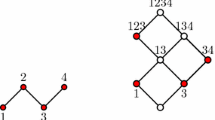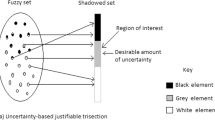Abstract
A three-way approximation of shadowed sets maps the membership grades of all objects into a three-value set with a pair of thresholds. The game-theoretic shadowed sets (GTSS) determine and interpret a pair of thresholds of three-way approximations based on a principle of tradeoff with games. GTSS formulate competitive games between the elevation and reduction errors. The players start from the initial thresholds (1,0) and perform the certain strategies to change the thresholds in the game. The games are repeated with the updated thresholds to gradually reach the suitable thresholds. However, starting from a pair of randomly selected non-(1,0) thresholds is not examined in GTSS. We propose a game approach to make it possible for GTSS starting from a pair of randomly selected thresholds and then determine the strategies associated with them. In particular, given a pair of randomly chosen initial thresholds, we use a game mechanism to determine the change directions that players prefer to make on the initial thresholds. The proposed approach supplements the GTSS, and can be added in the game formulation and repetition learning phases. We explain the game formulation, equilibrium analysis, and the determination of strategies in this paper. An example demonstrates how the proposed approach can supplement GTSS to obtain the thresholds of three-way approximations of shadowed sets when starting from randomly selected thresholds.
Access this chapter
Tax calculation will be finalised at checkout
Purchases are for personal use only
Similar content being viewed by others
References
Cattaneo, G., Ciucci, D.: An algebraic approach to shadowed sets. Electron. Notes Theoret. Comput. Sci. 82(4), 64–75 (2003)
Cattaneo, G., Ciucci, D.: Shadowed sets and related algebraic structures. Fundamenta Informaticae 55(3–4), 255–284 (2003)
Deng, X.F., Yao, Y.Y.: Decision-theoretic three-way approximations of fuzzy sets. Inf. Sci. 279, 702–715 (2014)
Deng, X.F., Yao, Y.Y.: Mean-value-based decision-theoretic shadowed sets. In: 2013 Joint IFSA and NAFIPS Annual Meeting, pp. 1382–1387. IEEE (2013)
Grzegorzewski, P.: Nearest interval approximation of a fuzzy number. Fuzzy Sets Syst. 130(3), 321–330 (2002)
Grzegorzewski, P.: Fuzzy number approximation via shadowed sets. Inf. Sci. 225, 35–46 (2013)
Pedrycz, W.: Shadowed sets: representing and processing fuzzy sets. IEEE Trans. Syst. Man Cybern. 28(1), 103–109 (1998)
Pedrycz, W.: Shadowed sets: bridging fuzzy and rough sets. In: Rough Fuzzy Hybridization. A New Trend in Decision-Making, pp. 179–199 (1999)
Pedrycz, W.: Interpretation of clusters in the framework of shadowed sets. Pattern Recogn. Lett. 26(15), 2439–2449 (2005)
Pedrycz, W., Vukovich, G.: Granular computing with shadowed sets. Int. J. Intell. Syst. 17(2), 173–197 (2002)
Tahayori, H., Sadeghian, A., Pedrycz, W.: Induction of shadowed sets based on the gradual grade of fuzziness. IEEE Trans. Fuzzy Syst. 21(5), 937–949 (2013)
Yao, J.T., Vasilakos, A.V., Pedrycz, W.: Granular computing: perspectives and challenges. IEEE Trans. Cybern. 43(6), 1977–1989 (2013)
Yao, Y.Y., Wang, S., Deng, X.F.: Constructing shadowed sets and three-way approximations of fuzzy sets. Inf. Sci. 412–413, 132–153 (2017)
Zabihi, S.M., Akbarzadeh-T, M.R.: Generalized fuzzy C-means clustering with improved fuzzy partitions and shadowed sets. ISRN Artif. Intell. 2012, 1–6 (2012)
Zadeh, L.A.: Fuzzy sets. In: Fuzzy Sets, Fuzzy Logic, and Fuzzy Systems: Selected Papers by Lotfi A Zadeh, pp. 394–432. World Scientific (1996)
Zhang, Y., Yao, J.T.: Game theoretic approach to shadowed sets: a three-way tradeoff perspective. Manuscript
Acknowledgements
This work is partially supported by a Discovery Grant from NSERC Canada.
Author information
Authors and Affiliations
Corresponding author
Editor information
Editors and Affiliations
Rights and permissions
Copyright information
© 2018 Springer International Publishing AG, part of Springer Nature
About this paper
Cite this paper
Zhang, Y., Yao, J. (2018). Determining Strategies in Game-Theoretic Shadowed Sets. In: Medina, J., et al. Information Processing and Management of Uncertainty in Knowledge-Based Systems. Theory and Foundations. IPMU 2018. Communications in Computer and Information Science, vol 854. Springer, Cham. https://doi.org/10.1007/978-3-319-91476-3_60
Download citation
DOI: https://doi.org/10.1007/978-3-319-91476-3_60
Published:
Publisher Name: Springer, Cham
Print ISBN: 978-3-319-91475-6
Online ISBN: 978-3-319-91476-3
eBook Packages: Computer ScienceComputer Science (R0)




